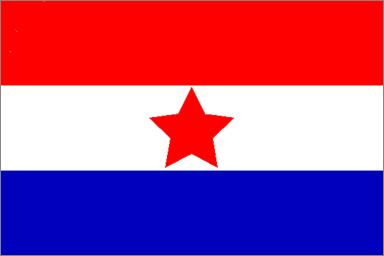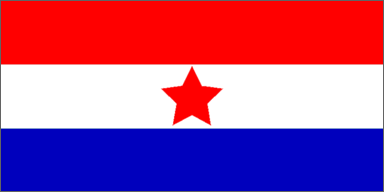
image by Janko Ehrlich - Zdvorak, 21 September 2001

Last modified: 2006-06-03 by dov gutterman
Keywords: croatia | antifascist movement | nopoj |
Links: FOTW homepage |
search |
disclaimer and copyright |
write us |
mirrors

image by Janko Ehrlich - Zdvorak, 21 September 2001

image by Janko Ehrlich - Zdvorak, 21 September 2001
See also:
On the meeting of Highest Command of the People's Liberation
Movement of Liberation of Yugoslavia (NOPOJ) and volunteer units
in Stolice (Serbia) on September 26, 1941 (confirmed by the
decree of Highest Command of the NOPOJ of October 1, 1941) was
decided that: "All headquarters and commandants of Partisan
units on their area must immediately find responding national
flags. In the middle of the flag and stretched over whole width
must be a five-pointed red star.".
According to this, members of the Croatian antifascist movement
(Partisans) were using as their flags Croatian red-white-blue
tricolour with a red star in the middle, touching edges of upper
and lower stripe.

First Partisan flag in Lika
image by Janko Ehrlich - Zdvorak, 21 September 2001
However, the first Partisan flag showed-up in Croatia was one
in Lika (Lika is a part of Croatia situated between Dalmatia and
the rest of Croatia (main city is GospiŠ (Gospic). There is
population mixed (Croats and Serbian minority).
but it was made half of Croatian and half of Serbian colours,
without any star.
Later, in 1943 at the third congress of United Antifascist
Council of People's Liberation of Croatia (ZAVNOH, kind of
parliament) was adopted and confirmed that Croatian flag is
tricolour with the red star. Of course, at that time there were
not any specific regulations related with dimensions. It is to
assume that old Bannate or Independent State of Croatia civil
flag were used with applied red star. Anyway, many examples were
made in other ratios.
Janko Ehrlich - Zdvorak, 21 September 2001
Reagring this stright-forward wouldn't it meant that the star
is reaching the top and bottom edges of the flag? Certainly this
was not the meaning.
Regarding the Lika flag, even if I havent done much research -
this was a one-time "incident" (though important, since
it was the first flag). Otherwise the traditonal tricolour flags
defaced with red stars were used - and usually both Croatian and
Serb tricolour were hoisted side by side. (I don't have any firm
sources to back up this, but at least I remember that a number of
propaganda posters made by Partisans in Croatia during and
imidiately after the War showed both flags.)
In some of the encyclopedias of JLZ (lexicographic institute in
Zagreb) once I have seen a flag that was suposedly the first
partisan naval ensign - that consisted of the Yugoslav tricolour
with star and canchor in its midde and with fly end having three
flags ove above the other, Slovenian, Croatian and Serbian
(Montenegrin). I think that it might have been in "Pomorski
leksikon" or in "Vojna enciklopedija", though not
in that issue of the last that I have checked. Since I saw it,
quicly in some used-books fair, I am trying to locate it again,
but in vain .
The practice of reusing other flags with application of the red
star was quite common, apparently. (I guess that Ustasha badge
would be removed first, for sure, though there was certainly a
good number of captured flags in rural areas where there was
never the badge appliqued anyway.
As an example it may be taken a flag of Croatian Pessants' Party
(HSS) from Goricica aroudn Sisak, shown on pages 140-141 of the
cataloge of the flag exhibition in the Croatian History Museum [bor96], the inventroy number HPM/PMH
11866: Croatian tricolour sized 117x375 cm, richly embroideried
with Peasants' Party emblems and agricultural motives, and maybe
one of the nicest flags in their collection. In the middle of the
flag it is visible stain that is left from, probably sewed, red
fivepointed star that was presumably added during the WWII, and
presumably it was latter removed, or it was lost, before the item
came to Museum. Sisak area was very active in Anti-Fascist
strougle.
IMHO, this stains make this museum item even more interesting and
providing much bigger story then an already nice flag would do in
itself. I would very much like to lear more about the story of
this flag.
I am sure that there are other flag in Croatian History Museum
that have similar features, and certainly there should be more
such examples in local museums, too.
Željko Heimer, 28 September 2001

image by Željko Heimer, 26 March 2006
I received a letter from Mislav Miholek, who
specialized into study of history of WWII in Croatia especially
the military history. I summarize and translate it as follows:
The flag used by Croatian partisans - displayed on the local
conference of the National Liberation Commettee in Jastrebarsko
in May 1945. The drawing made by Mislav according to a photo published in a
monography celebrating 25 years of the 2nd Session of ZAVNOH
(Zemaljsko Antifašisticko vijece narodnog oslobodenja
Hrvatske - Regional Antifascist Council for the National
Liberation of Croatia - the governing body of Democratic Federal
Croatia within Yugoslavia).
The flag is vertically displayed national tricolour with the coat
of arms set in the middle and above it a red five-pointed star. I
guess that the flag was in existance before 1945 (even before
1941 - as the order of red and white cheques suggests) without
the star that was added to it after the partisans took over, like
in several other examples of such flags preserved in the museums
in Croatia.
I mentioned red-first Coat of Arms as (probable) evidence of the
provinence of the flag being from before 1941, since after that
date the Coat of Arms would have almost surely be made with the
white-first square. If it were not the Coat of Arms on the flag
in the first place when partisans entered Jastrebarsko, the star
would be applied almost surely without the Coat of Arms on the
tricolour - they would not bother to make the Coat of Arms on it.
Željko Heimer, 26 March and 17 April 2006